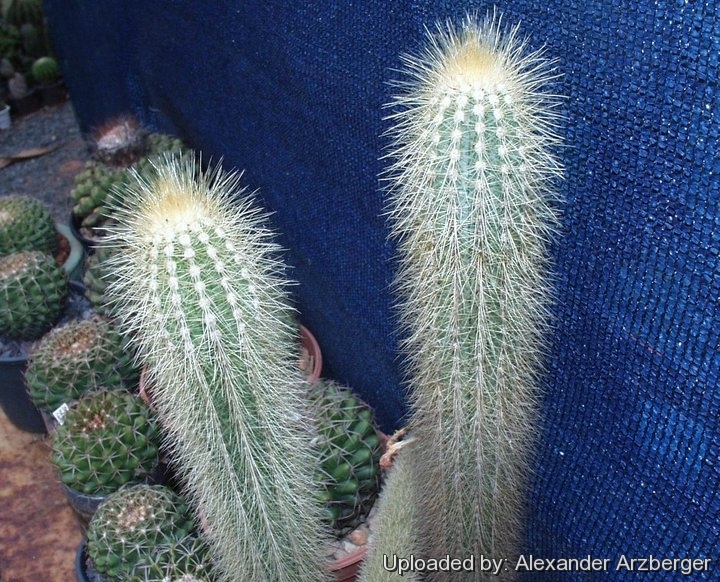
Pilosocereus lanuginosus subs. tillianus Photo by: Alexander Arzberger
Origin and Habitat: Pilosocereus tillianusSN|33068]]SN|33068]] is endemic to Lagunillas, Merida state, Venezuela. Several thousand individuals occur in habitat. It occurs in high densities.
Altitude range: It occurs from 600-1200 metres above sea level.
Habitat and Ecology: This species occurs in flatlands and slopes within inter-Andean dry valley. It is predominantly an outcrossing species but partially self-compatible. It is bat-pollinated and bats and birds disperse the seeds. The inter-Andean dry valleys represent an important reservoir of plant and animal species adapted to xeric conditions. Given the current isolation of these dry enclaves, they may represent important areas of speciation and endemicity. It is very probable that each enclave contains populations undergoing the speciation process, and some of the columnar cacti could represent currently unrecognised endemics. This species is listed as Endangered because it has a very restricted distribution (extent of occurrence is approximately 262 km2) and it is known from only one location which is under high pressure from urban and agricultural development.
Synonyms:
See all synonyms of Pilosocereus lanuginosus
Description: Pilosocereus tillianusSN|6560]]SN|33068]] is a columar cactus composed of slender, tubular shaped branches up to several metres tall. Pilosocereus tillianusSN|6560]]SN|33068]] looks very attractive when young.
Stems: Cylindrical, erect, strongly blue at first, becoming blue-green and glaucous ribbed with multiple sections.
Spines: 20-25 feathery, flexible, yellow, later grey, not differentiated into radials and centrals.
Flowers: Pilosocereus tillianusSN|33068]]SN|33068]] produces flowers 3-3.5 cm long in discrete pulses, suggesting this cactus might exhibit pulsed flowering — a rare flowering pattern among angiosperms.
Taxonomy: Anderson (2001) and Hunt et al. (2006) treated Pilosocereus tillianusSN|33068]]SN|33068]] as a synonym of Pilosocereus lanuginosusSN|33068]]SN|6560]] (L.) Bowles & G.D.Rowley, but indicated that it was distinctive and may warrant subspecific recognition. P. lanuginosus is a very variable and widely distributed species in NW South America, synonymising the numerous names published from the same geographic area. (Guiggi (Cactology 2: 12. 2010) recognize it as distinct subspecies: (Pilosocereus lanuginosusSN|33068]]SN|6560]] subs. tillianus). P. tillianus shows a considerably high genetic diversity compared to other species. The hight levels of genetic variability may depends on poliploidy, (it is autotetraploid), gene dispersal driven by bat and bird pollination and seed dispersal, and (a vicariant speciation scenario, in which the current reduced geographic distribution of P. tillianus represents a relict of a former widespread species.
Subspecies, varieties, forms and cultivars of plants belonging to the Pilosocereus lanuginosus group
- Pilosocereus lanuginosus (L.) Byles & G.D.Rowley: (subsp. lanuginosus) Spines 8-12, differentiated into radials and centrals, rigid; flowers 5-6 cm long.
- Pilosocereus lanuginosus subs. colombianus (Rose) Guiggi: spines 10-25, blackish, acicular to subulate, Flowers pinkish-white, fruits pulp red. Distribution:
- Pilosocereus lanuginosus subs. moritzianus (Otto ex Pfeiff.) Guiggi: Stem dark green, spines 6-12, subulate, brownish.
 Pilosocereus lanuginosus subs. tillianus (R.Gruber & Schatzl) Guiggi: Spines 20-25, not differentiated into radials and centrals, flexible, flowers 3-3.5 cm long. Distribution: Lagunillas, Merida state, Venezuela.
Pilosocereus lanuginosus subs. tillianus (R.Gruber & Schatzl) Guiggi: Spines 20-25, not differentiated into radials and centrals, flexible, flowers 3-3.5 cm long. Distribution: Lagunillas, Merida state, Venezuela.
Bibliography: Major references and further lectures
1) Edward F. Anderson “The Cactus Family” Timber Press, 2001
2) David Hunt, Nigel Taylor “The New Cactus Lexicon” DH Books, 2006
3) Theodore H. Fleming, Alfonso Valiente-Banuet “Columnar Cacti and Their Mutualists: Evolution, Ecology, and Conservation” University of Arizona Press, 2002
4) Figueredo, C.J., Nassar, J.M., García-Rivas, A.E. and González-Carcacía, J.A. “Population genetic diversity and structure of Pilosocereus tillianus (Cactaceae, Cereeae), a columnar cactus endemic to the Venezuelan Andes.” Journal of Arid Environments 74(11): 1392-1398, 2010.
5) Hokche, O., Berry, P.E. and Hiber, O. “Nuevo Catálogo de la Flora Vascular de Venezuela.” Fundación Instituto Botánico de Venezuela, Caracas, Venezuela. 2008.
6) Nassar, J.M., N. Ramírez and O. Linares. “Comparative pollination biology of Venezuelan columnar cacti and the role of nectar-feeding bats in their sexual reproduction.” American Journal of Botany 84(8): 918-927, 1997.
7) Soriano, P.J. and Ruiz, A. “The role of bats and birds in the reproduction of columnar cacti in the Northern Andes.” In: T. Fleming and A. Valiente-Banuet (eds), “Columnar Cacti and Their Mutualists”, pp. 241–263. The University of Arizona Press, Tucson. 2002.
8) Nassar, J. 2013. Pilosocereus tillianus. The IUCN Red List of Threatened Species 2013: e.T16331465A16331468. http://dx.doi.org/10.2305/IUCN.UK.2013-1.RLTS.T16331465A16331468.en. Downloaded on 09 July 2016.
9) C.J. Figueredo, J.M. Nassar, A.E. García-Rivas, J.A. González-Carcacía “Population genetic diversity and structure of Pilosocereus tillianus (Cactaceae, Cereeae), a columnar cactus endemic to the Venezuelan Andes” in: Journal of Arid Environments Volume 74, Issue 11, November 2010, Pages 1392–1398
10) Guiggi “THE REVISED TAXONOMY OF PILOSOCEREUS LANUGINOSUS (LINNAEUS) BYLES ET ROWLEY (CACTOIDEAE-CEREEAE) FROM NORTH-WESTERN SOUTH-AMERICA” in Cactology 2: 10-16, 2010
11) Miguel A. Munguía-Rosas , Vinicio J. Sosa “Phenology of Pilosocereus leucocephalus (Cactaceae, tribe Cereeae): a columnar cactus with asynchronous pulsed flowering” Plant Ecology November 2010, Volume 211, Issue 1, pp 191-201
Cultivation and Propagation: It is quite tender and not an easy plant from seed.










